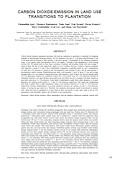| Journal Article |
 |
|
| Article Title | Carbon dioxide emission in land use transitions to plantation | | Author | Fahmuddin Agus, Eleonora Runtunuwu, Tania June, Erni Susanti, Herna Komara, Haris Syahbuddin, Irsal Las and Meine van Noordwijk | | Year | 2009 | | Journal Title | Jurnal Litbang Pertanian | | Volume | 28 | | Issue | 4 | | Pages | 119-126 | | Call Number | JA0368-10 | | Keywords | Carbon dioxide emission, carbon sequestration, land use transition, plantations, peatlands, mineral soils |
|
| Abstract: |
| Carbon dioxide emission assessment associated with land use transitions to agriculture is important for designing strategies in reducing green house gas emission. Net CO2 emissions is the sum of 1) the above ground biomass C loss of the initial land use because of land clearing, 2) the above ground C accumulation by the subsequent plantation crops, 3) soil organic matter decomposition, and 4) soil organic C burning if land management or land clearing involves fire. For mineral soils, in most cases, conversion of primary and secondary forests with time average C stocks of about 300 and 132 t/ha, respectively, results in a net C emission. However, if shrub or Imperata grassland, with respective C stocks of 15 and 2 t/ha is rehabilitated to plantation, it generally results in a net C sequestration. For peat soil, CO2 emission is caused by peat decomposition, peat burning (if any), and the aboveground C decomposition and/or burning. Rehabilitating peat shrub (with assumed C stock of about 15 t/ha and average
drainage depth of 40 cm) instead of clearing peat forest (with assumed C stock of about 200 t/ha and drainage depth of 0) for agriculture reduces CO2 emissions of about 862 t CO2-e/ha/25 year (34 t CO2-e/ha/year) because of substantial reduction in the plant biomass and possible peat soil carbon loss due to burning. Peat shrub remains as
peat shrub emits about 22 t CO2-e/ha/year. If peat shrub is rehabilitated to paddy field, rubber plantation or oil palm plantation, the emission levels become 11, 7, and 30 t CO2-e/ha/year, respectively. This means that rehabilitating peat shrub to paddy field or rubber plantation, results in net emission reduction of 11 and 15 t CO2-e/ha/year,
respectively, whereas rehabilitating it to oil palm plantation increases net emission of only 8 t CO2-e/ha/year, relative to leaving the peat shrub as is. Therefore, new plantation development should be prioritized on mineral soils’ shrub and Imperata grasslands or on peat shrub as these conversions, in most cases, result in the net CO2
sequestration and potentially improve the livelihood of the communities. |
|
